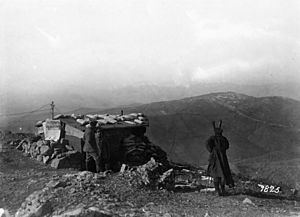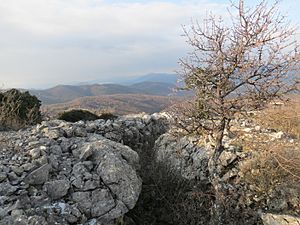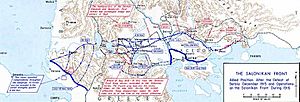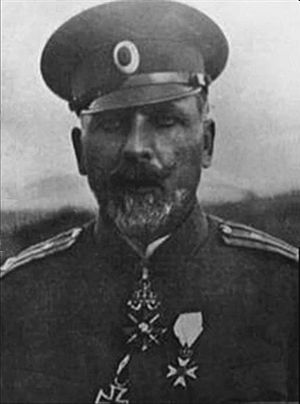Battle of Doiran (1917) facts for kids
Quick facts for kids Battle of Doiran |
|||||||
|---|---|---|---|---|---|---|---|
| Part of Macedonian front (World War I) | |||||||
 A Bulgarian telephone station with trench periscope observing the enemy's position at the Doiran front, March 1917 (German Official Photograph/National Archives). |
|||||||
|
|||||||
| Belligerents | |||||||
| Commanders and leaders | |||||||
| Strength | |||||||
|
|
||||||
| Casualties and losses | |||||||
| 100 | 12,000 | ||||||
The Battle of Doiran was a major fight during World War I in 1917. It took place between the armies of the United Kingdom and Bulgaria. This battle happened near Lake Dojran in what is now North Macedonia. The Bulgarian forces successfully defended their positions against a strong British attack.
Contents
Planning the Attack
At a meeting in Chantilly, the Allied forces decided to try and break through the enemy lines. Their goal on the Macedonian front was to defeat the Bulgarian army. They wanted to push through the Balkans quickly.
The Allied commanders planned a big attack near the Vardar River and Doiran. In 1917, the Bulgarian 9th Pleven Infantry Division took over the defenses at Doiran. This division was led by Colonel Vladimir Vazov.
Early Fights and Preparations
On February 9 and 10, the Allies attacked two Bulgarian regiments. But the Bulgarians fought back hard and pushed them away. A British advance on February 21 was also stopped by Bulgarian artillery fire. This happened after two days of fighting.
The Allied commanders saw that the Bulgarian defenses were very strong. So, they ordered a heavy artillery bombardment of these positions. They also moved their own troops closer, about 800 to 1,500 meters from the Bulgarian lines.
To break through, the British gathered three divisions. These were the 22nd, 26th, and 60th Divisions. They had over 43,000 men, 160 guns, 110 mortars, and 440 machine guns. Their main target was a 5-6 km wide area towards Kalatepe.
Bulgarian commanders learned from their spies that a big Allied attack was coming. The 9th Pleven Division was strengthened. It had 30,000 men, 147 guns, 35 mortars, and 130 machine guns.
The Bulgarian front was split into three sections. The right section, 13 km wide, was defended by 1st Brigade. The central section, 4 km wide, was held by the 57th Regiment. The left section, 9 km wide, was defended by 2nd Brigade.
Strong Defenses
In 1917, the Bulgarian defenses were made even stronger. They had two main lines of trenches. These trenches were 1.5 to 2 meters deep. They were also 200 to 1000 meters apart and connected by passages.
In front of these trenches were two lines of wire entanglements, like barbed wire. Between the trenches, there were watchpoints, shelters, machine-gun nests, and hidden artillery. Behind these defenses, they built concrete bunkers and ammunition storage areas. There were also smaller forts in front of the main line. A second defense line was partly built 2 to 5 km behind the first.
The Battle Begins
The battle to break the Bulgarian lines started on April 22. It continued on and off until May 9, 1917. The attack began with a very intense four-day artillery barrage. The British fired about 100,000 shells. This destroyed earthworks and some wooden structures in the front lines.
The Bulgarians also fired back from their own batteries. Colonel Vladimir Vazov ordered his troops to fire day and night on the Allied positions. After several hours of British and Bulgarian artillery fighting, the Bulgarians fired 10,000 shells in just one hour.
The British infantry attacked on the night of April 24–25. Twelve companies attacked the Bulgarian 2nd Brigade. After a fierce fight, they managed to capture some positions. However, a Bulgarian counterattack pushed the British back. They suffered heavy losses and retreated by 8 pm. British attacks on other parts of the front were also stopped. This was thanks to strong Bulgarian artillery fire.
British attacks over the next two days were also defeated. Constant Bulgarian fire and counterattacks pushed them back. Because of these heavy losses, the British pulled back to their starting positions on April 27. The Bulgarians immediately began rebuilding their damaged defenses.
The British command was not happy with the results. So, they ordered new attempts to break through. On May 8, after another long artillery barrage, they launched a new attack. The main assault began at 9 pm. Five waves of British troops attacked the Bulgarian positions. After four attacks during the night of May 8–9, the British were defeated. They suffered huge casualties. A reporter from The Times newspaper wrote that British soldiers called one point "the valley of death."
Even though the artillery fighting continued until May 9, the British had to stop all attacks. They had lost too many soldiers. They had 12,000 killed, wounded, or captured. The Bulgarian defenders buried 2,250 of the British dead. The 9th Pleven Infantry Division lost 2,000 men. About 900 of these died from disease and wounds.
After this victory, Vladimir Vazov was promoted to Major-General.
Aftermath of the Battle
After the battle, the front was mostly quiet for the next 16 months. Both sides used this time to make their positions even stronger. In 1918, a large attack by British and Greek forces was again stopped by the Pleven Division. This happened in the Third Battle of Doiran.
Images for kids







